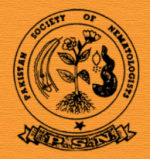Response of Soil Nematode Communities to Zero-Tillage Weed Control Practices
Response of Soil Nematode Communities to Zero-Tillage Weed Control Practices
William K. Heve* and Isaac D. Otabil
Feeding groups of diverse soil-borne nematode communities retrieved from 200 mL of soil samples taken from plots that had different treatments: (A) bacteria feeding, (B) omnivorous, (C) fungi feeding, (D) plant feeding, (E) protoctist, alga or moss feeding Tylenchus, and (F) total of all nematodes in soil samples from plots. Dunn’s test at P ≤ 0.05 showed that different italicized lowercase letters on top of bars in each of the images (A–F) denote significant difference in ‘mean±SE’ values of numbers of nematodes between treatments across plots.
Soil-borne communities of plant feeding nematodes that belong to the genus: (A) Pratylenchus; (B) Meloidogyne; (C) Tylenchorhynchus; (D) Amplimerlinius. According to Dunn’s test at P ≤ 0.05, different italicized lowercase letters on top of bars in each of the images (A–D) represent significant difference in ‘mean ±SE’ values of numbers of nematodes between treatments across plots.







